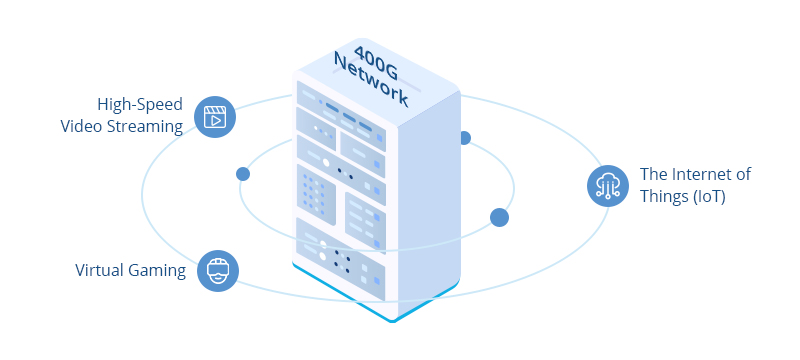5G Pushing the 400G Network Transformation
With the rapid technological disruption and the wholesale shift to digital, several organizations are now adopting 5G networks, thanks to the fast data transfer speeds and improved network reliability. The improved connectivity also means businesses can expand on their service delivery and even enhance user experiences, increasing market competitiveness and revenue generated.
Before we look at how 5G is driving the adoption of 400G transformation, let’s first understand what 5G and 400G are and how the two are related.
What is 5G?
5G is the latest wireless technology that delivers multi-Gbps peak data speeds and ultra-low latency. This technology marks a massive shift in communication with the potential to greatly transform how data is received and transferred. The increased reliability and a more consistent user experience also enable an array of new applications and use cases extending beyond network computing to include distributed computing.
And while the future of 5G is still being written, it’s already creating a wealth of opportunities for growth & innovation across industries. The fact that tech is constantly evolving and that no one knows exactly what will happen next is perhaps the fascinating aspect of 5G and its use cases. Whatever the future holds, one is likely certain: 5G will provide far more than just a speedier internet connection. It has the potential to disrupt businesses and change how customers engage and interact with products and services.
What is 400G?
400G or 400G Ethernet is the next generation of cloud infrastructure that offers a four-fold jump in max data-transfer speed from the standard maximum of 100G. This technology addresses the tremendous bandwidth demands on network infrastructure providers, partly due to the massive adoption of digital transformation initiatives.
Additionally, exponential data traffic growth driven by cloud storage, AI, and Machine Learning use cases has seen 400G become a key competitive advantage in the networking and communication world. Major data centers are also shifting to quicker, more scalable infrastructures to keep up with the ever-growing number of users, devices, and applications. Hence high-capacity connection is becoming quite critical.
How are 5G and 400G Related?
The 5G wireless technology, by default, offers greater speeds, reduced latencies, and increased data connection density. This makes it an attractive option for highly-demanding applications such as industrial IoT, smart cities, autonomous vehicles, VR, and AR. And while the 5G standard is theoretically powerful, its real-world use cases are only as good as the network architecture this wireless technology relies on.
The low-latency connections required between devices, data centers, and the cloud demands a reliable and scalable implementation of the edge-computing paradigms. This extends further to demand greater fiber densification at the edge and substantially higher data rates on the existing fiber networks. Luckily, 400G fills these networking gaps, allowing carriers, multiple-system operators (MSOs), and data center operators to streamline their operations to meet most of the 5G demands.
5G Use Cases Accelerating 400G transformation
As the demand for data-intensive services increases, organizations are beginning to see some business sense in investing in 5G and 400G technologies. Here are some of the major 5G applications driving 400G transformation.
High-Speed Video Streaming
The rapid adoption of 5G technology is expected to take the over-the-top viewing experience to a whole new level as demand for buffer-free video streaming, and high-quality content grows. Because video consumes the majority of mobile internet capacity today, the improved connectivity will give new opportunities for digital streaming companies. Video-on-demand (VOD) enthusiasts will also bid farewell to video buffering, thanks to the 5G network’s ultra-fast download speeds and super-low latency. Still, 400G Ethernet is required to ensure reliable power, efficiency, and density to support these applications.
Virtual Gaming
5G promises a more captivating future for gamers. The network’s speed enhances high-definition live streaming, and thanks to ultra-low latency, 5G gaming won’t be limited to high-end devices with a lot of processing power. In other words, high-graphics games can be displayed and controlled by a mobile device; however, processing, retrieval, and storage can all be done in the cloud.
Use cases such as low-latency Virtual Reality (VR) apps, which rely on fast feedback and near-real-time response times to give a more realistic experience, also benefit greatly from 5G. And as this wireless network becomes the standard, the quantity and sophistication of these applications are expected to peak. That is where 400G data centers and capabilities will play a critical role.
The Internet of Things (IoT)
Over the years, IoT has grown and become widely adopted across industries, from manufacturing and production to security and smart home deployments. Today, 5G and IoT are poised to allow applications that would have been unthinkable a few years ago. And while this ultra-fast wireless technology promises low latency and high network capacity to overcome the most significant barriers to IoT proliferation, the network infrastructure these applications rely on is a key determining factor. Taking 5G and IoT to the next level means solving the massive bandwidth demands while delivering high-end flexibility that gives devices near real-time ability to sense and respond.
400G Ethernet as a Gateway to High-end Optical Networks
Continuous technological improvements and the increasing amount of data generated call for solid network infrastructures that support fast, reliable, and efficient data transfer and communication. Not long ago, 100G and 200G were considered sophisticated network upgrades, and things are getting even better.
Today, operators and service providers that were among the first to deploy 400G are already reaping big from their investments. Perhaps one of the most compelling features of 400G isn’t what it offers at the moment but rather its ability to accommodate further upgrades to 800G and beyond. What’s your take on 5G and 400G, or your progress in deploying these novel technologies?
Source: community.fs
Related products...
fiber-optic-cable
fiber-optic-cable
fiber-optic-cable
fiber optic cable 12 core Armored, (2*6), singlemode, OSSC-SJ















[ratings]